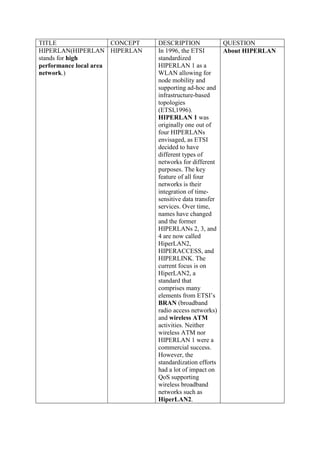
Hiperlan
- 1. TITLE CONCEPT DESCRIPTION QUESTION HIPERLAN(HIPERLAN HIPERLAN In 1996, the ETSI About HIPERLAN stands for high standardized performance local area HIPERLAN 1 as a network.) WLAN allowing for node mobility and supporting ad-hoc and infrastructure-based topologies (ETSI,1996). HIPERLAN 1 was originally one out of four HIPERLANs envisaged, as ETSI decided to have different types of networks for different purposes. The key feature of all four networks is their integration of time- sensitive data transfer services. Over time, names have changed and the former HIPERLANs 2, 3, and 4 are now called HiperLAN2, HIPERACCESS, and HIPERLINK. The current focus is on HiperLAN2, a standard that comprises many elements from ETSI’s BRAN (broadband radio access networks) and wireless ATM activities. Neither wireless ATM nor HIPERLAN 1 were a commercial success. However, the standardization efforts had a lot of impact on QoS supporting wireless broadband networks such as HiperLAN2.
- 2. Elimination-yield non- EY-NPMA EY-NPMA divides preemptive priority ● Prioritization the medium access of multiple access (EY- ● Contention different competing NPMA) ● Transmission nodes into three phases: Prioritization phase EY-NPMA Determine the highest Work of phase priority of a data packet ready to be sent by competing nodes. Contention phase EY-NPMA Eliminate all but one Work of phase of the contenders, if more than one sender has the highest current priority Transmission phase EY-NPMA Finally, transmit the Work of phase packet of the remaining node. In a case where several nodes compete for the medium, all three phases are necessary (called ‘channel access in synchronized channel condition’). If the channel is free for at least 2,000 so- called high rate bit- periods plus a dynamic extension, only the third phase, i.e. transmission, is needed (called ‘channel access in channel-free condition’). Types of contention Contention The contention phase Two types phase phase is further subdivided into an elimination phase and a yield phase. Elimination phase Contention Several nodes may Explanation phase now enter the elimination phase. Again, time is divided into slots, using the elimination slot
- 3. interval IES = 212 high rate bit periods. The length of an individual elimination burst is 0 to 12 slot intervals long, the probability of bursting within a slot is 0.5. The probability PE(n) of an elimination burst to be n elimination slot intervals long is given by: ● PE(n) = 0.5n+1 for 0 ≤ n < 12 ● PE(n) = 0.512 for n = 12 The elimination phase now resolves contention by means of elimination bursting and elimination survival verification. yield phase Contention During the yield Explanation phase phase, the remaining nodes only listen into the medium without sending any additional bursts. Again, time is divided into slots, this time called yield slots with a duration of IYS = 168 high rate bit- periods. The length of an individual yield listening period can be 0 to 9 slots with equal likelihood. The probability PY(n) for a yield listening period to be n slots long is 0.1 for all n, 0 ≤ n ≤ 9. Each node now listens for its yield listening period. If it senses the channel is idle during the whole period, it has survived the yield listening. Otherwise, it withdraws for the rest
- 4. of the current transmission cycle. This time, the length of the yield phase is determined by the shortest yield- listening period among all the contending nodes. At least one node will survive this phase and can start to transmit data. This is what the other nodes with longer yield listening period can sense. It is important to note that at this point there can still be more than one surviving node so a collision is still possible. Quality of service QoS The speciality of Explanation support and other HIPERLAN 1 is its specialties QoS support. The quality of service offered by the MAC layer is based on three parameters (HMQoS- parameters). The user can set a priority for data, priority = 0 denotes a high priority, priority = 1, a low priority. The user can determine the lifetime of an MSDU to specify timebounded delivery. The MSDU lifetime specifies the maximum time that can elapse between sending and receiving an MSDU Power conservation is achieved by setting up certain recurring patterns when a node
- 5. can receive data instead of constantly being ready to receive. Special group- attendance patterns can be defined to enable multicasting. All nodes participating in a multicast group must be ready to receive at the same time when a sender transmits data. HIPERLAN 1 MAC also offers user data encryption and decryption using a simple XOR-scheme together with random numbers First of all, the MAC layer determines the normalized residual HMPDU lifetime (NRL). This is the residual lifetime divided by the estimated number of hops the PDU has to travel. The computation reflects both the waiting time of a PDU in the node and the distance, and the additional waiting times in other nodes. Then the MAC layer computes the channel access priority for each PDU. The final selection of the most important HMPDU (HIPERLAN 1 MAC PDU) is performed in the following order: ● HMPDUs with the highest priority are
- 6. selected; ● from these, all HMPDUs with the shortest NRL are selected; ● from which finally any one without further preferences is selected from the remaining HMPDUs.